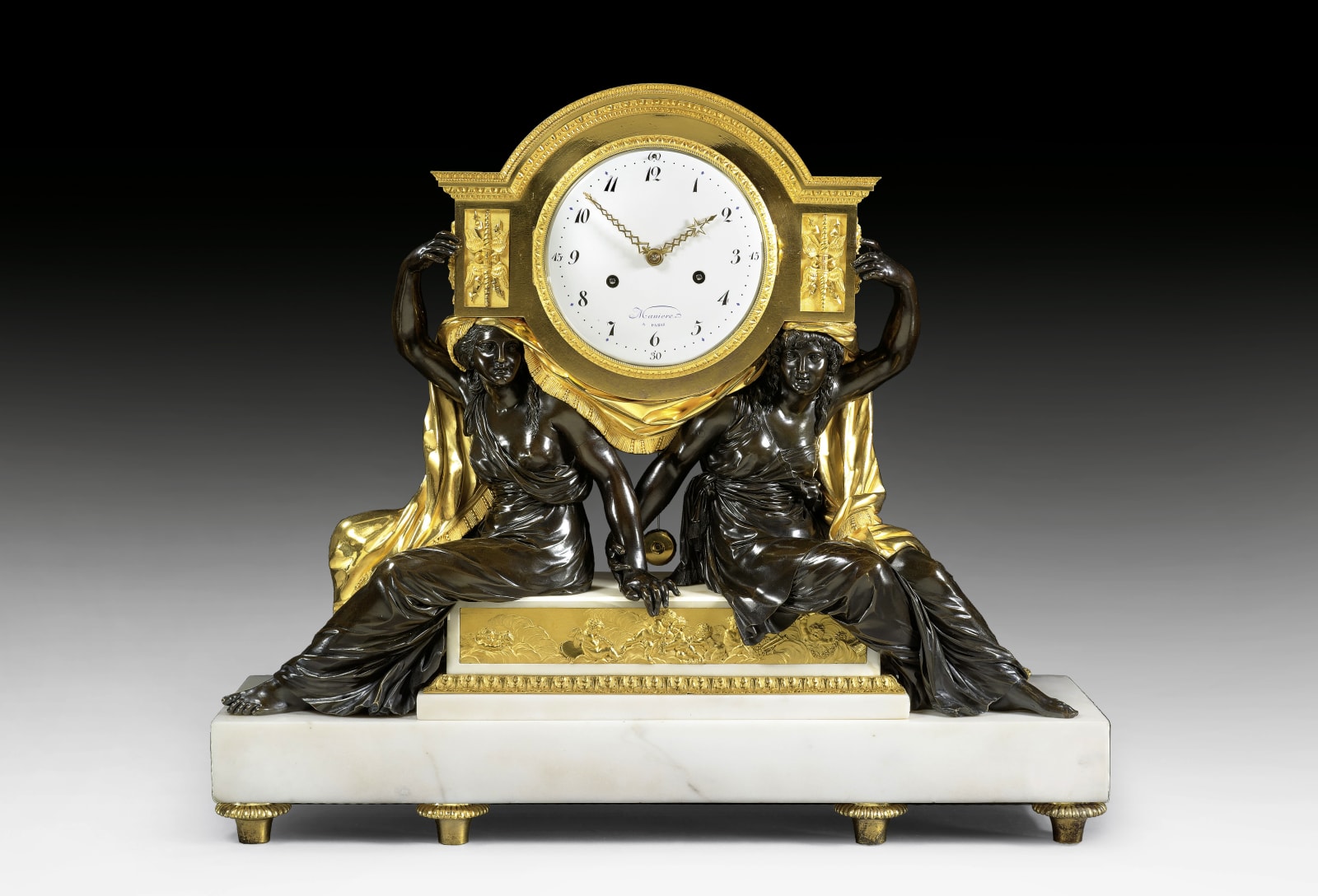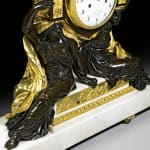Charles-Guillaume Manière
Further images
Provenance
Comte Henri de Beaumont.
A very important late Louis XVI gilt and patinated bronze and white marble mantel clock of eight day duration with movement by Charles-Guillaume Manière and magnificent case attributed to François Rémond. The white enamel dial signed Maniere à Paris with Arabic numerals and a pier of pierced gilt brass hands for the hours and minutes.
The movement with silk thread suspension, anchor escapement, striking on the hour and half our on a single bell, with outside count wheel. The case with circular dial set within an arched rectangular case with egg-and-dart and leaf-tipped frieze, supported by two patinated classically dressed female figures with gilt drapery encircling the base of the clock and falling to their knees, the females holding hands and seated on a stepped rectangular white marble plinth mounted with a gilt frieze depicting putti making music and playing upon clouds, on a plain rectangular marble base supported by gadrooned toupie feet
Paris, date circa 1785-90
Height 53 cm, width 63 cm, depth 17 cm.
This impressive sculptural clock, from the collection of the late comte Henri de Beaumont is not only rare but of great importance. Almost certainly made to an order for the marchand-mercier Dominique Daguerre, the movement was made by Parisian horloger Charles-Guillaume Hautemanière, known as Manière (d. after 1812), who like the renowned bronzier François Rémond (b. circa 1747, d. 1812) often supplied Daguerre. The attribution of the case to Rémond can be confirmed by similarities between this and other models by this eminent bronzier. Notable among them are at least three related clocks (one illustrated in Pierre Kjellberg, "Encyclopédie de la Pendule Française du Moyen Age au XXe Siècle", 1997, p. 331, pl. E and two others in private collections). The latter examples all have movements by Manière and feature the same caryatid classical females though the pair stand rather than sit and a pediment rather than an arch surmounts the dial. Despite these differences the women's faces remain very similar, as is the positioning of their raised hands and the drapery encircling their heads and upper torsos. Furthermore the feet supporting the marble bases are all of the same type. Another related clock with movement again by Manière featuring similar standing females includes a child as a surmount and a palmette frieze on the base (sold in Monaco 1988).
The origins of the case model can be traced in detail to Rémond's register of sales, which records that in 1785 he first produced (probably to the order of the duc de Penthièvre) a pair of candelabra, which were held aloft by the same figures. Another pair, probably delivered by Daguerre to Princesse Kinsky for her hôtel in rue St. Dominique, swiftly followed this order. The candelabra undoubtedly proved a success and in 1790 Rémond used the same female caryatids on the clock case to equal acclaim, (Charles Baulez, "La Luminaire de la Princesse Kinsky", in "L'Estampille/L'Objet d'Art", no. 247, May 1991, p. 88, pls. 1-3). Since the present clock is so evidently dependant on the model developed by Rémond in 1790, then it too must have been created by him at the about the same time.
The recent discovery of Rémond's sales' registry as well as other research has revealed him to be one of the most successful Parisian bronziers during the latter part of Louis XVI's reign. Received as a maître-doreur in 1774 his meteoric rise to fame ensured that by 1786 he had the fourth highest capital among some eight hundred other bronziers in Paris. Working as fondeur and ciseleur as well as doreur he was able to exercise a considerable amount of artistic control over his output. In particular he worked extensively for Daguerre, for whom he supplied work valued at the substantial sum of 920,000 livres between 1778-92. Among important commissions from Daguerre, Rémond created the mounts for a number of celebrated pieces of furniture including a lacquer-mounted toilet table by Adam Weisweiler (Musée du Louvre), which was delivered by Daguerre to Marie-Antoinette in 1784. In addition Rémond made mounts for a marquetry dressing table by Riesener, also made for the Queen for her apartments at the Petit Trianon (now at Waddesdon Manor, Buckinghamshire) as well as for a number of marvellous pieces by David Roentgen for the Russian Imperial Court.
Like Rémond, Manière was much favoured by Daguerre as evident from Daguerre's probate inventory made after his death 1796, which records six clocks with movements by Manière; records also show that at the time of his death Daguerre still owed Manière 180 livres. Manière, the son of a Parisian maître-horloger, Jean-Pierre (d. after 1789) became a maître in 1778. At that time he was established at rue du Four-Saint-Honoré; by 1781 he had moved to rue des Prouvaires and by 1789 to rue Mercier. He later moved to rue Christine, 1806 and four years later was recorded at rue Bertin-Poirée.
In addition to working extensively for Daguerre during his early career Manière also supplied many pieces to the Darnaults. His clocks were regarded as much as for their mechanical excellence as for their aesthetic value, with many of the cases being made by and in collaboration with such eminent bronziers as Pierre-Philippe Thomire and François Rémond. Manière also used cases by Jean-Baptiste Osmond, Claude Galle, Edme Roy and François Vion. Examples of such collaborations and other time pieces by Manière can be found in many public collections including the Châteaux de Fontainebleau and Versailles, in Paris at the Musée des Arts Décoratifs and Musée Nissim-de-Camondo as well as the Patrimonio Nacional in Madrid. In addition the Museum of Decorative Arts in Prague, the Palazzo del Quirinale in Rome and Palazzo Reale in Turin, as well as the Hermitage Museum, Saint Petersburg and Woburn Abbey, Woodstock, Oxfordshire also own examples from his outstanding oeuvre.





